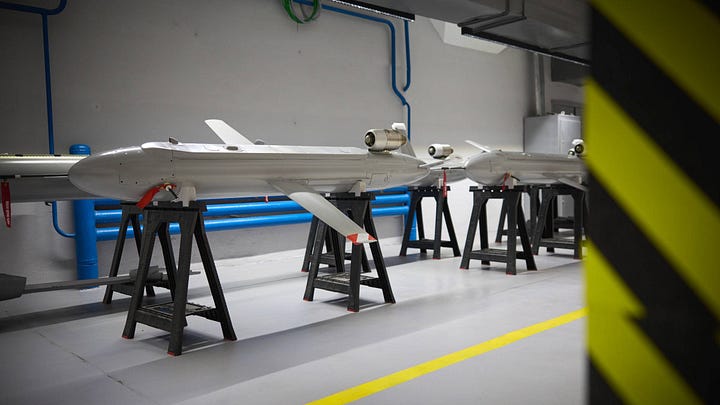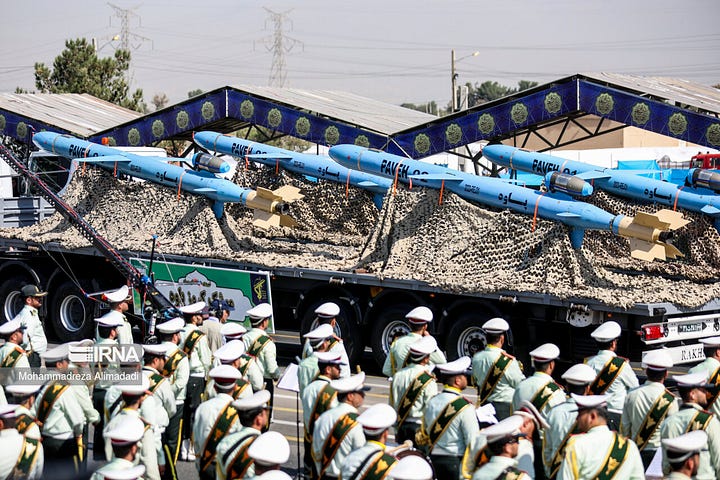Concepts–themed posts engage in inherently somewhat speculative analysis. I contend that any serious analysis must engage with the world both as it is and as it can be. Avoiding mindless empiricism requires cognizance of what is and what is not within the realm of possibility. Concepts-themed posts engage in this type of analysis.
One of the more interesting developments in the Russia-Ukraine War has been Ukraine’s development and deployment of several low-cost land-attack cruise missiles, namely the Peklo, Bars, and Palianytsia. There is nothing ground-breaking about any of these three Ukrainian land-attack cruise missile designs, which employ commercial off-the-shelf (COTS) components, and it bears emphasis that low-cost cruise missile designs were hardly without precedent prior to the development and introduction of the aforementioned Ukrainian designs. Ukraine is, however, the first country to employ such low-cost land-attack cruise missiles in large numbers, and the Ukrainian experience is instructive in terms of highlighting one of the many ways that China can sustain a high-intensity extended strike campaign against Taiwan.




Land-attack cruise missiles were originally developed and deployed by the United States and the Soviet Union as a means of delivering nuclear weapons over long distances. When adapted for the purposes of delivering high explosive warheads, such land-attack cruise missiles, which were powered by quite fuel-efficient and high power density turbofan engines, were typically used to deliver a 400-500 kilogram warhead over a distance of 1500 or so kilometers. By the late 1990s, a new generation of air-launched land-attack cruise missiles, primarily of the air-launched variety, were in development to deliver a 400-500 kilogram high explosive warhead over a distance of 400-500 kilometers.
While such cruise missiles amounted to performance benchmarks that other countries, China included, sought to emulate, designers worldwide always had other options. Countries that did not have access to suitable compact turbofan engines, for example, were forced to rely on less fuel-efficient turbojet engines, which resulted in a lower maximum range, or, more accurately described, a lower payload-range. This posed a particular challenge for one country, Iran, which sought a land-attack cruise missile with a maximum range of at least 1300 or so kilometers to target Israel from Iranian territory. Iran eventually developed and deployed such a land-attack cruise missile, the Paveh, by the late 2010s, even though it did not have access to a suitable compact turbofan engine.




The Paveh, which is best characterized as an evolving family of land-attack cruise missiles that is also known as the Quds in the hands of Ansarallah in Yemen, offers Iran the ability to attack targets located 1000 or more kilometers way. The Paveh’s design, particularly its quite modest turbojet engine, however, results in a considerably lower payload-range than the likes of the American Tomahawk land-attack cruise missile. The Paveh can only be used to deliver a much smaller warhead over a comparable maximum range and exists in several versions configured for different range-payload optimizations, which is to say that shorter-range versions of the Paveh are equipped with a larger warhead than the longest-range versions, which are equipped with a much smaller warhead (and additional fuel). Ansarallah in Yemen appears to operate a reduced-payload, extended range version of the Paveh with a maximum range of 1800 or so kilometers to attack the most distant targets in the Arabian Peninsula and Israel.
While the Iranian Paveh constituted a template for a low-cost and long-range, albeit low payload—low payload-range—land-attack cruise missile that Ukraine could have pursued, it instead pursued smaller, lighter, and lower payload-range land-attack cruise missiles in the form of the Peklo, Bars, and Palianytsia. These Ukrainian designs use COTS turbojet engines, including some of Chinese manufacture, which are much lower maximum thrust designs than even the quite modest turbojet installed on the Iranian Paveh, let alone the much higher-end land-attack cruise missiles deployed by the likes of the United States, Russia, China, France, Germany, and the United Kingdom, among others. As a result, the Ukrainian Peklo, Bars, and Palianytsia can only be used to deliver a high explosive warhead weighing just several tens of kilograms over a distance of 500-1000 kilometers. As with the Iranian Paveh, there is some scope to trade payload for range and vice versa, but the use of a low-cost COTS turbojet engine, which results in a quite low maximum take-off weight cruise missile, inherently offers little scope for making such a trade with the aforementioned Ukrainian land-attack cruise missile designs without severely reducing the destructive effects of the warhead.
The Taiwan Strait is just 130-180 kilometers wide at its narrowest points. The entirety of the island of Taiwan lies within 350 kilometers of the Chinese coastline. With cruise missiles often following complex flight paths to avoid high elevation terrain and known concentrations of air defences, a Chinese land-attack cruise missile with a maximum range of 500 kilometers will be more than adequate to attack essentially any target on the island of Taiwan. Most of Taiwan’s population, and most of the potential targets for Chinese strike munitions, are, however, located on Taiwan’s quite narrow western coastal plain, which typically extends over a depth of just 25-35 kilometers, and are therefore much more proximate to the Chinese coastline. As a result, a notional Chinese land-attack cruise missile with a maximum range of just 250-300 kilometers will be able to attack most of the potential targets for Chinese strike munitions on the island of Taiwan.
While China can deploy something in the vein of the Ukrainian Peklo, Bars, and Palianytsia, it can pursue such designs with a different payload-range configuration, which is to say a land-attack cruise missile that carries a substantially larger payload over a shorter difference or, alternatively, an even smaller and, all else being equal, less expensive, lower payload-range land-attack cruise missile design. A 350-kilometer maximum range analogue to the aforementioned Ukrainian designs should be able to deliver a 90-kilogram class warhead to attack a target located along Taiwan’s western coastal plain. Alternatively, a substantially smaller and, all else being equal, less expensive land-attack cruise missile can be used to, for example, deliver a 30-40 kilogram class warhead to attack a target located along Taiwan’s western coastal plain.
As of this writing, there is no public indication that the People’s Liberation Army (PLA) has pursued, let alone deployed, low-cost and low payload-range land-attack cruise missiles of this type. Such notional land-attack cruise missiles are, of course, nothing like the high-end strike munitions that the PLA Rocket Force (PLARF) increasingly focuses on, and do not appear to be in accordance with the Central Military Commission’s preferred approach(es) to waging a cross-strait conflict. However much Chinese decision-makers may prefer a short and sharp war, China is, absent its own capitulation, likely to end up in a protracted war with Taiwan, the United States, and perhaps other countries. Should a Chinese amphibious invasion of the island of Taiwan be indefinitely postponed or fail, China will likely seek to force Taiwan into submission through an extended strike campaign alongside what amounts to one formulation or another of a maritime blockade. In such a scenario, large numbers of low-cost land-attack cruise missiles along the lines of what has been discussed in this post constitute one way that China can prosecute such a strike campaign.
A protracted conflict is not, however, the only scenario in which China may use such munitions. While more expensive than, for example, unpowered guided glide bombs or propeller-driven fixed-wing strike drones, low payload-range cruise missiles can be launched in large salvos against high-value targets so as to induce the depletion of Taiwan’s finite stocks of on-island surface-to-air missiles, including shoulder-launched surface-to-air missiles that the PLARF high-end strike munitions cannot be used to degrade or neutralize in the opening hours and days of a conflict. Depending on the PLA’s preferred basing modes, ground-launched land-attack cruise missiles of this type can even be launched in large salvos at very short notice in the opening hours and days of a war alongside the PLARF’s higher-end munitions. It bears emphasis that if and when Taiwan’s large but nevertheless finite stocks of on-island surface-to-air missiles—including those that are necessarily located in targetable storage sites—are depleted, the PLA Air Force (PLAAF) will, in effect, have a free hand when it comes to undertaking extensive air-to-ground sorties with standoff and non-standoff munitions alike. As a result, low-cost and low payload-range land attack cruise missiles are not simply something that China can pursue if its preferred approaches to a cross-strait war fail; these can also be used to facilitate China’s preferred approaches to a cross-strait conflict.
While low-cost land-attack cruise missiles can be readily intercepted, it is important to keep in mind that Taiwan will only have a finite number of on-island surface-to-air missiles, including shoulder-fired surface-to-air missiles, at its disposal. Wartime resupply is not impossible, but is unlikely to result in the delivery of hundreds, let alone thousands, of surface-to-air missiles in wartime. There is, as such, merit to an air defence interceptor depletion strategy that runs in parallel to the CMC and PLARF’s preferred air defence system neutralization strategy, which requires high-end systems that will always be available in far more limited numbers than low-cost land-attack cruise missiles. While China can also use other types of strike munitions, such as even less expensive (single-use) propeller-driven fixed-wing strike drones to attack targets on Taiwan, cruise missiles are, alongside ballistic missiles and large-caliber guided artillery rockets, more generally, among the subset of candidate strike munition types that can be used to more readily induce the expenditure of Taiwan’s surface-to-air missiles. Unlike slow propeller-driven strike drones, cruise missiles, even those that are equipped with a fairly low thrust COTS turbojet engine, are difficult to intercept using small arms and manually aimed machine guns, and a higher flight speed inherently reduces the interception window for such short-range, low-cost, and widely deployed (in wartime) air defence capabilities.
Any serious analysis of China’s prospects in various cross-strait conflict scenarios must engage with the world both as it is and as it can be. This requires cognizance of what is and what is not within the realm of possibility in terms of PLA capabilities that exist on the first day of a major conflict or PLA capabilities which only arise in wartime for use in an increasingly plausible protracted conflict scenario. Low-cost and low payload-range land-attack cruise missiles constitute one of several possible approaches that China may use to attack targets on Taiwan or, failing that, to deplete and degrade Taiwan’s air defence capabilities so as to enable other Chinese strike capabilities to attack targets on Taiwan.

